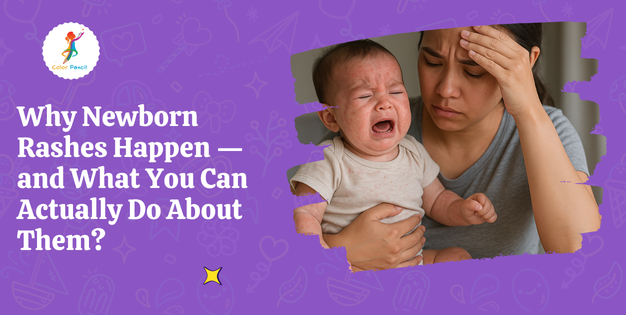
Top 10 Flashcard Combos for Holistic Toddler Learning
Did you know that up to 80% of a toddler’s brain develops in the first five years? As a parent, you’re likely eager to give

You’ve just brought your newborn home, and suddenly—tiny red bumps, splotches, or dry patches appear on their delicate skin. Sound familiar? Don’t panic. Most newborn rashes are completely normal and go away on their own. Still, it can be hard to tell what’s harmless and what requires attention.
In this guide, we’ll walk you through the most common baby rash types, why they happen, how to treat them at home, and when it’s time to call your pediatrician.
Babies are born with incredibly sensitive skin that’s adjusting to the outside world. After months in the womb, even minor environmental changes—like air exposure, heat, detergents, or clothing friction—can trigger a reaction.
Common causes of newborn rashes include:
Most of the time, these rashes are more startling than serious—and they’re rarely painful for your baby.
Here are the most frequently seen baby rash types (with or without red dots), and how to manage each:
What it is:
A common newborn rash that appears in the first few days of life. It’s harmless and doesn’t require treatment.
How to identify:
Solution:
No treatment is necessary. Keep skin clean and dry; avoid heavy lotions.
Medical attention needed?
No. This rash is totally normal and will resolve on its own.
What it is:
Tiny white or pearly bumps caused by dead skin trapped in pores.
How to identify:
Solution:
Just wait it out. These bumps go away within a few weeks—no scrubbing or creams needed.
Medical attention needed?
No. Milia are a harmless, temporary condition.
What it is:
Small pimples caused by hormones passed from mom to baby during pregnancy.
How to identify:
Solution:
Wash baby’s face gently with water and pat dry. Avoid creams or over-the-counter acne treatments.
Medical attention needed?
Only if the rash worsens or becomes irritated or infected.
What it is:
Irritation of the skin in the diaper area caused by moisture, friction, or prolonged contact with urine/stool.
How to identify:
Solution:
Medical attention needed?
Yes, if the rash doesn’t improve after a few days or looks infected (blisters, pus, fever).
What it is:
A rash caused by blocked sweat glands, especially in warm or humid environments.
How to identify:
Solution:
Medical attention needed?
Not usually—just monitor and keep baby comfortable.
A newborn allergic rash can happen if your baby reacts to a new formula, detergent, or skincare product. These rashes may appear as red, blotchy hives or widespread irritation.
What to do:
If you notice your newborn developing a rash, it might be an allergic reaction to a new product. Learn about skincare products that are safe for your baby to ensure you’re using the best, most gentle options for your baby’s sensitive skin.
Most baby rashes are harmless. However, call your doctor if your child’s rash is:
Knowing when to worry about a rash on a child can give you peace of mind—and catch something serious early if needed.
Less is more with newborn skin.
Your baby’s skin is self-regulating. Harsh soaps, scented lotions, or over-cleansing can do more harm than good. Most newborn rashes resolve with time, gentle care, and a watchful eye.
Feeling Overwhelmed? Let’s Talk! Join Our Parent Forum and Get Expert Advice & Support!
Yes. Most babies will experience at least one harmless skin rash in their first few weeks of life.
Call your pediatrician if the rash is painful, spreading, blistered, or paired with fever or lethargy.
Heat rash, baby acne, or irritation are all common causes of red dots or bumps.
Frequent changes, gentle cleansing, and barrier creams like zinc oxide are usually effective.
Yes. Newborns can react to formulas, foods (via breastmilk), detergents, or lotions. These rashes often look like hives or red blotches.